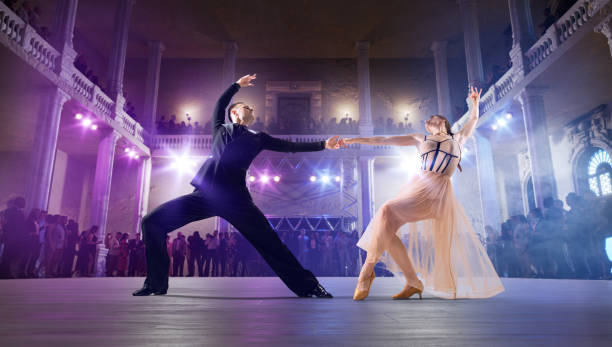If you think all dancing is the same, think again. The moment you step into a studio or onto a stage, you’ll realise something: social dance takes many forms, and each has its own flavor.
On one side, you have polished, spotlight-ready performances where every step is rehearsed.
On the other hand, there’s the casual energy of a social dance floor where improvisation and connection rule the night.
Curious about what makes them different? Let’s explore the key contrasts that shape your experience as a dancer.
Contents
- 1 1. Choreography vs. Freestyle
- 2 2. Expressing to the Crowd vs. Connecting to Your Partner
- 3 3. Dress Code and Presentation
- 4 4. Practiced Precision vs. Spontaneous Skill
- 5 5. Performance Pressure vs. Social Fun
- 6 6. Predictable Music vs. Musical Surprises
- 7 7. Competitive Recognition vs. Community Belonging
- 8 Why Choose One When You Can Have Both?
- 9 Wrap Up
1. Choreography vs. Freestyle
One of the biggest differences comes down to structure.
Stage dance is planned to the last detail. Whether you’re performing West Coast Swing, salsa, or bachata, you’ll:
- Memorise sequences of steps
- Practice timing for dramatic effect
- Repeat the same routine over and over until it’s perfect
In contrast, social dancing in Singapore (or pretty much anywhere) is more about going with the flow.
You don’t rely on choreography. Instead, you learn how to lead or follow and adapt to the music as it plays. No two dances feel the same, and that’s the beauty of it.
2. Expressing to the Crowd vs. Connecting to Your Partner
When you perform on stage, you have one mission: capture the audience’s attention. Every move must look big enough to reach the back row, and your expressions are intentionally exaggerated to show energy and emotion.
Social dancing has a different purpose. You aren’t trying to impress a crowd; you’re focused on your partner. You listen for subtle signals and respond with equally subtle movements. It’s almost like a conversation, one you carry out without saying a word.
This is why dancers often feel that social dance helps them build deeper connection skills, while stage dance sharpens their confidence in front of others.
3. Dress Code and Presentation
If you’ve ever watched a stage performance, you know costumes are half the fun. Think:
- Sequined dresses
- Tailored shirts
- Bright colours that shine under lights
These outfits are designed to dazzle an audience and fit the theme of the performance.
On the social floor, comfort is king. Most dancers wear:
- Lightweight clothes for ease of movement
- Dance shoes with suede soles
- Simple accessories (if any)
The goal isn’t to look like a star but to feel comfortable enough to dance all night.
4. Practiced Precision vs. Spontaneous Skill
In stage dance, perfection is everything. You practice endlessly so that you can consistently deliver the same performance, regardless of the circumstances.
Social dancing is different. Since you’re dancing with many partners, you learn how to adjust on the spot. You might:
- Modify your timing if your partner is slower or faster
- Change the styling to suit a new song
- Adapt your lead or follow to different skill levels
Many dancers find this flexibility to be one of the most rewarding parts of social dance.
5. Performance Pressure vs. Social Fun
Stage performances come with natural pressure. There’s an audience watching, sometimes judges scoring you, and the lights make everything feel more intense. Even experienced performers admit to feeling nervous.
In contrast, social dancing feels relaxed and communal. You might be dancing with a stranger or a friend, but everyone is there to enjoy themselves. Mistakes are met with laughter, not criticism.
If you’re new to dancing, social nights are a great way to build confidence without worrying about perfection.
6. Predictable Music vs. Musical Surprises
Performing on stage often means dancing to the same track every time. You know when the beats drop, where to hit accents, and exactly how long the routine lasts.
Social dancing keeps you on your toes. DJs play different songs with unexpected tempos and styles. You get to:
- Listen carefully
- Interpret rhythms creatively
- Adapt your movement to the mood of the music
This musical variety is why many dancers say social dancing in Singapore never feels boring.
7. Competitive Recognition vs. Community Belonging
Stage dancing is sometimes competitive. You might be performing for prizes or recognition. The stakes feel higher, and you’re judged on everything from technique to stage presence.
Social dance is more about connection. You’ll find communities that welcome everyone, from beginners to professionals. Weekly socials, dance festivals, and casual practice nights are all chances to meet people and grow your skills in a friendly environment.
Why Choose One When You Can Have Both?
Performance and social dancing are two sides of the same coin.
Performance Mode delivers:
- Structure
- Discipline
- The rush of applause
Social Mode offers:
- Creativity
- Connection
- Pure, no-judgment fun
In Singapore, you don’t have to pick a single lane. Many dancers toggle between showcase nights and casual socials in the same week. The versatility keeps things fresh and makes you a stronger dancer overall.
Wrap Up
If you’re curious to build your skills, consider starting with a class or workshop. ZiggyFeet Dance Studio is an excellent launchpad with classes, dance socials, and performance opportunities.
Then jump into a social event to practice in real time. Whether you’re spotlight-ready or just here to vibe, the mission stays the same.



